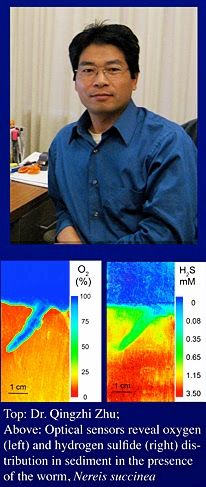 This semester, SoMAS welcomed Dr. Qingzhi Zhu as Assistant Professor. Dr. Zhu has been part of the SoMAS community, as a research scientist and adjunct faculty member working with Dr. Robert Aller, since 2002. Dr. Zhu, who received his doctorate in Chemistry in 1997 from Xiamen University, China, specializes in the development and application of optical sensors for examination of biogeochemical heterogeneity and dynamics in marine sediments.
This semester, SoMAS welcomed Dr. Qingzhi Zhu as Assistant Professor. Dr. Zhu has been part of the SoMAS community, as a research scientist and adjunct faculty member working with Dr. Robert Aller, since 2002. Dr. Zhu, who received his doctorate in Chemistry in 1997 from Xiamen University, China, specializes in the development and application of optical sensors for examination of biogeochemical heterogeneity and dynamics in marine sediments.
Dr. Zhu cam to SoMAS after two years at the Technical University of Munich, Germany, where he studied hydrochemisty as a recipient of an Alexander Von Humboldt Foundation Research Fellowship.
Dr. Zhu is a first-rate analytical chemist,” says Dr. Kirk Cochran. “In his time at SoMAS, Zhu has developed innovative optical chemical sensors that permit new observations of biogeochemical reactions associated with organic matter diagenesis in marine sediments. The research in this area is virtually unique to Stony Brook.”
Dr. Zhu’s sensors can be used to examine a two-dimensional plane going perpendicularly into the sediment. They enable researchers to make in situ observations of properties such as pH, oxygen, or hydrogen sulfide. “It’s like looking through the window of an ant farm,” says Dr. Zhu. “It’s important to be able to examine an area without disturbing it. Before these sensors, we could not make observations around a feature like a worm burrow because moving a sediment sample into the lab for measurement was likely to disturb its physical, chemical, and biological characteristics. Now with these sensors, we are able to watch as the concentration and spatial distribution of solutes change over time.”
By obtaining measurements of chemical and biological parameters with high spatial and temporal resolution, researchers can better conceptualize and model heterogeneous biogeochemical reactions, microbial metabolism, and solute transport in bioturbated deposits, “These measurements can help us confirm and refine the models,” says Dr. Zhu.
Dr. Zhu’s reserach interests have evolved from pure chemistry through environmental chemistry to biogeochemistry. He recently received an NSF grant to study measurement of vitamin B12 in the water column and sediment. Dr. Zhu says he likes the integrated nature of his research here at SoMAS. “Multidisciplinary research is interesting,” he says.




You must be logged in to post a comment.